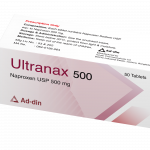Composition
Each 5 ml contains Albendazole USP 200 mg.
Pharmacology
Albendazole is a broad spectrum anthelmintic. Albendazole exhibits vermicidal, ovicidal and larvicidal activities. The drug is thought to exert its anthelmintic effect by blocking glucose uptake in the susceptible helminths, thereby depleting the energy level until it becomes inadequate for survival. Immobilization is followed by the parasite. These events may be a consequence of the binding and subsequent inhibition of parasite tubulin polymerization by Albendazole and its metabolites, although the drug also binds to human tubulin. Albendazole is extensively metabolized, probably in the liver. Albendazole is poorly absorbed from the gastrointestinal tract but rapidly undergoes extensive first-pass metabolism. The principal metabolite albendazole sulphoxide has anthelmintic activity and a plasma half-life of about 8.5 hrs. It is excreted in the urine together with other metabolites.
Indications
Aldaben is indicated in single and mixed infestations of Pinworm or threadworm, whipworm, large roundworm, hookworm, tapeworm
Dosage and Administration
Adults or children over 2 years of age: 10 ml Suspension as a single dose.
In case of strongyloidiasis 10 ml suspension as a single dose for 3 consecutive days. If the patient is not cured on follow-up after three weeks, a second course of treatment is indicated.
Children of 1-2 years of age: 5 ml Suspension.
Children under 1 year of age: Not recommended.
Contraindications
Neonates: Albendazole is not normally used in neonates.
Children: Reduction of the dose from 400 mg to 200 mg may be indicated in children weighing less than 10 kg but there are no grounds for a general reduction in dosage to children.
Pregnant woman: Albendazole should not be given during pregnancy or women thought to be pregnant. No information is available on placental transfer.
Concurrent disease: There is no evidence to suggest that the dose should be altered in renal, hepatic or cardiac failure.
Warning and Precautions
Blood counts and liver function tests before treatment and twice during each cycle; breastfeeding; exclude pregnancy before starting treatment. Albendazole should only be used in the treatment of Echinococcosis if there is constant medical supervision with regular monitoring of serum-transaminase concentrations and of leucocyte and platelet counts.
Side Effects
Gastrointestinal disturbances, headache, dizziness, changes in liver enzymes, rarely reversible alopecia; rash, fever, blood disorders including leucopenia and pancytopenia reported; allergic shock if cyst leakage; convulsion and meningism in cerebral disease.
Use in Pregnancy & Lactation
Pregnancy category D. Albendazole is contraindicated during pregnancy and for one month prior to conception. In order to avoid administering albendazole during early pregnancy, women of childbearing age (15-45) should initiate treatment during the first week of menstruation or after a negative pregnancy test. Breast-feeding should be discontinued during and for a minimum of 5 days after treatment.
Interaction
No interaction involving Albendazole, either pharmacodynamic or pharmacokinetic, has been reported.
Overdosage
Overdose affects the liver, testicles, and GI tract the most. It can manifest with lethargy, loss of appetite, vomiting, diarrhea, intestinal cramps, dizziness, convulsions, and sleepiness. There is no specified antidote.
Storage
Store in a cool, dry place, away from light. Keep out of reach of children.
Packaging
Bottle containing 10 ml suspension.






